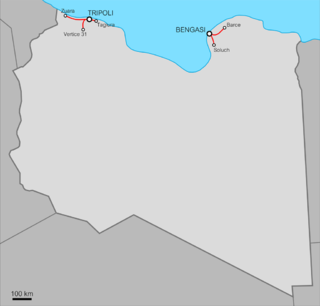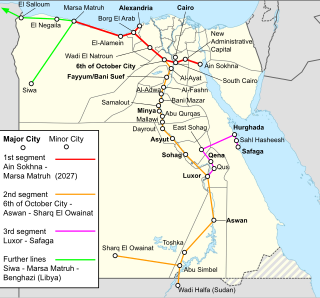
Misrata or Misratah, also known by the Italian spelling Misurata, is a city in the Misrata District in northwestern Libya, situated 187 km (116 mi) to the east of Tripoli and 825 km (513 mi) west of Benghazi on the Mediterranean coast near Cape Misrata. With a population of about 881,000, it is the third-largest city in Libya, after Tripoli and Benghazi. It is the capital city of the Misrata District and has been called the trade capital of Libya. The harbor is at Qasr Ahmad.

Tripolitania, historically known as the Tripoli region, is a historic region and former province of Libya.
Hitachi Rail Italy S.p.A. is a multinational rolling stock manufacturer company based in Pistoia, Italy. Formerly AnsaldoBreda S.p.A., a subsidiary of state-owned Finmeccanica, the company was sold in 2015 to Hitachi Rail of Japan. After the deal was finalized, the current name was adapted in November 2015 to reflect the new ownership.

Egyptian National Railways is the national railway of Egypt and managed by the parastatal Egyptian Railway Authority.

Sirte, also spelled Sirt, Surt, Sert or Syrte, is a city in Libya. It is located south of the Gulf of Sirte, between Tripoli and Benghazi. It is famously known for its battles, ethnic groups, and loyalty to Muammar Gaddafi. Also due to developments in the First Libyan Civil War, it was briefly the capital of Libya as Tripoli's successor after the Fall of Tripoli from 1 September to 20 October 2011. The settlement was established in the early 20th century by the Italians, at the site of a 19th-century fortress built by the Ottomans. It grew into a city after World War II.
This is a list of planned, or proposed, high-speed rail projects by country. Although a number of countries have conducted preliminary feasibility studies, many lines are eventually shelved or postponed due to high costs; only a few nations are building high-speed rail lines. Planned lines are separated here from lines under construction, and some countries have both. High-speed rail is public transport by rail at speeds over 200 km/h.
Castelverde, also named Gasr Garabulli, is a town in the Tripoli District (Tarabulus), of the Tripolitania region in northwestern Libya.
The Société Nationale des Chemins de Fer Tunisiens, abbreviated SNCFT, is the national railway of Tunisia and under the direction of the Ministry of Transport. SNCFT was founded on December 27, 1956 It Replaced the Tunisian Railway Farms Company (CFT). Headquartered in Tunis the company employs about 6000 people. SNCFT provides both passenger and freight services at a national level.

There were few railway stations built in Libya during the 20th century. The ones that were built were done so by the Italians from the 1920s as part of their colonial administration. Today there are no functioning railway stations active in the country, but new ones are planned, as part of a new railroad system.

The Libyan Coastal Highway, formerly the Litoranea Balbo, is a highway that is the only major road that runs along the entire east-west length of the Libyan Mediterranean coastline. It is a section in the Cairo–Dakar Highway #1 in the Trans-African Highway system of the African Union, Arab Maghreb Union and others.
The 2007-08 Libyan Third Division was the 24th edition of the Libyan Third Division football. It took place from November 2007 to June 2008. Wefaq Ajdabiya won the title, having won the championship playoffs between the winners of the regional leagues.

Libyan railways are the Italian colonial railways in Italian Libya. They are related to the development of the railways in the Italian colonial empire. This history started with the opening in 1888 of a short section of line in Italian Eritrea, and ended in 1947 with the loss of Italian Libya after the Allied offensive in North Africa and the destruction of the railways around Italian Tripoli. The railways in the Italian colonial empire reached 1,561 km before World War II.

The National Liberation Army, officially the National Liberation Armed Forces of the Free Libyan Republic, formerly known as the Free Libyan Army, was a Libyan military organisation affiliated with the National Transitional Council, which was constituted during the First Libyan Civil War by defected military members and civilian volunteers, in order to engage in battle against both remaining members of the Libyan Armed Forces and paramilitia loyal to the rule of Muammar Gaddafi. Its self proclaimed chief commander was General Khalifa Haftar, although the National Transitional Council preferred to appoint Major General Abdul Fatah Younes Al-Obeidi as its commander-in-chief. It had prepared for some time in portions of Eastern Libya controlled by the anti-Gaddafi forces for eventual full-on combat in Western Libya against pro-Gaddafi militants, training many men before beginning to go on the offensive. They have battled for control of Benghazi, Misrata, Brega, Ajdabiya, Zawiya and Ra's Lanuf as well as several towns in the Nafusa Mountains. They finally began the Battle for Tripoli in August 2011 when they attacked from the west of the city, as well as fomenting an internal uprising on 20 August.

Libyan refugees are people who fled or were expelled from their homes since the beginning of the Libyan Crisis in 2011, including during the First Libyan Civil War, that deposed Muammar Gaddafi in 2011, and the Second Libyan Civil War (2014–2020). Many people have been displaced from Libya to neighbouring Tunisia, Egypt and Chad, as well as to European countries across the Mediterranean. The majority of refugees from Libya are Arabs, though many others are sub-Saharan African migrants who were living in Libya. These groups were also among the first refugee waves to exit the country. The total number of Libyan refugees was estimated at around one million in June 2011, with most returning to Libya after the First Civil War ended. In January 2013, there were 5,252 refugees originating from Libya alongside 59,425 internally displaced persons registered by the UNHCR.

The timeline of the First Libyan Civil War begins on 15 February 2011 and ends on 20 October 2011. It begins with a series of peaceful protests, similar to others of the Arab Spring, later becoming a full-scale civil war between the forces loyal to Muammar Gaddafi's government and the anti-Gaddafi forces. The conflict can roughly be divided into two periods before and after external military intervention authorized by United Nations Security Council Resolution 1973.

Italian Libya Railways was a group of railways built in the Italian colony of Libya between the two World Wars.
This is a detailed timeline of the Libyan civil war (2014–2020) which lasted from 2014 to 2020.

The Italian colonial railways started with the opening in 1888 of a short section of line in Italian Eritrea, and ended in 1943 with the loss of Italian Libya after the Allied offensive in North Africa and the destruction of the railways around Italian Tripoli. The colonial railways of the Kingdom of Italy reached 1,561 kilometres (970 mi) before WWII.

Egypt has no operational high-speed rail links, but a project was launched in 2018 to construct three such lines with a total length of about 2,000 kilometres (1,200 mi). The first line links the cities of Ain Sukhna and Marsa Matrouh, the second connects the cities of Sixth of October and Abu Simbel, and the third connects the city of Qena with the cities of Hurghada and Safaga.
















